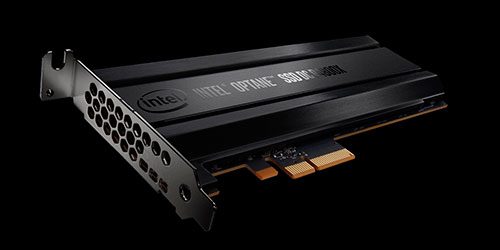March has been a busy month for Intel’s storage division.
Last week, the chipmaker launched its DC P4800X, an Optane-based PCIe solid-state drive (SSD) for servers. Optane is a memory architecture intended to bridge the performance gap between storage and DRAM.
In the case of the DC P4800X, it provides 375GB of capacity that appears as DRAM to operating system software and applications. According to Intel’s testing, the SSD can deliver read and write input/output operations per second (IOPS) ratings of up to 550,000 and 500,000, respectively. Latency is rated at under 10 microseconds.
Jack E. Gold, founder and principal analyst at J. Gold Associates, isn’t expecting Intel to use Optane to directly compete with flash drives.
“Rather, we expect Optane to be priced on a per byte basis between DRAM and NAND flash,” said Gold in a research note sent to InfoStor. “As a result, we estimate Optane based SSDs will initially be priced at a 50 percent to 75 percent premium compared to SSD equivalent devices, although on a price/performance basis, Optane will be a better value for process intensive applications,” including big data, analytics, virtual reality, artificial intelligence and other demanding workloads.
Optane won’t be unseating the current crop of SSDs any time soon, added Gold.
“While many have focused on Optane’s ability to take market share away from traditional NAND storage devices, we believe that is missing the point. The true advantage of Optane, once machines are properly designed/configured for its unique capabilities, is that it can significantly increase performance and act as a processing accelerator,” he said.
On the PC front, Intel this week debuted its new Optane Memory modules. Available in 16GB and 32GB capacities when they ship on April 24, the M.2 boards aren’t meant to replace hard disk drives (HDDs), but rather act as a high-speed cache.
“With the increased speed and responsiveness of Intel Optane memory in a 7th Gen Intel Core processor-based system, you can power on your computer up to twice as fast and improve overall system performance up to 28 percent faster with storage performance up to 14x faster,” wrote Navin Shenoy, senior vice president and general manager of the Client Computing Group at Intel, in a March 27 announcement. “Applications like Microsoft Outlook will launch up to nearly 6x faster, the Chrome browser launches up to 5x faster, games launch up to 67 percent faster, and levels load up to 65 percent faster.”
Intel Optane Memory modules require seventh-generation Intel Core “Kaby Lake” processors and motherboards with compatible chipsets. In the second quarter, HP, Dell and other vendors will begin offering commercial and consumer PCs with the technology, added Shenoy.
Pedro Hernandez is a contributing editor at Datamation. Follow him on Twitter @ecoINSITE.



